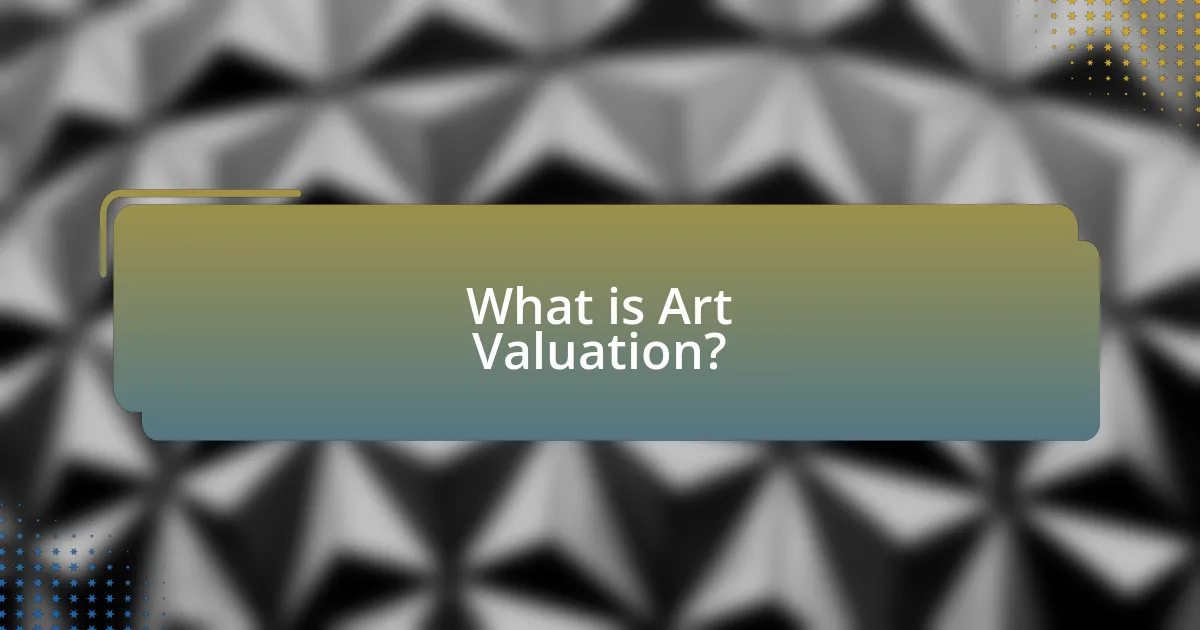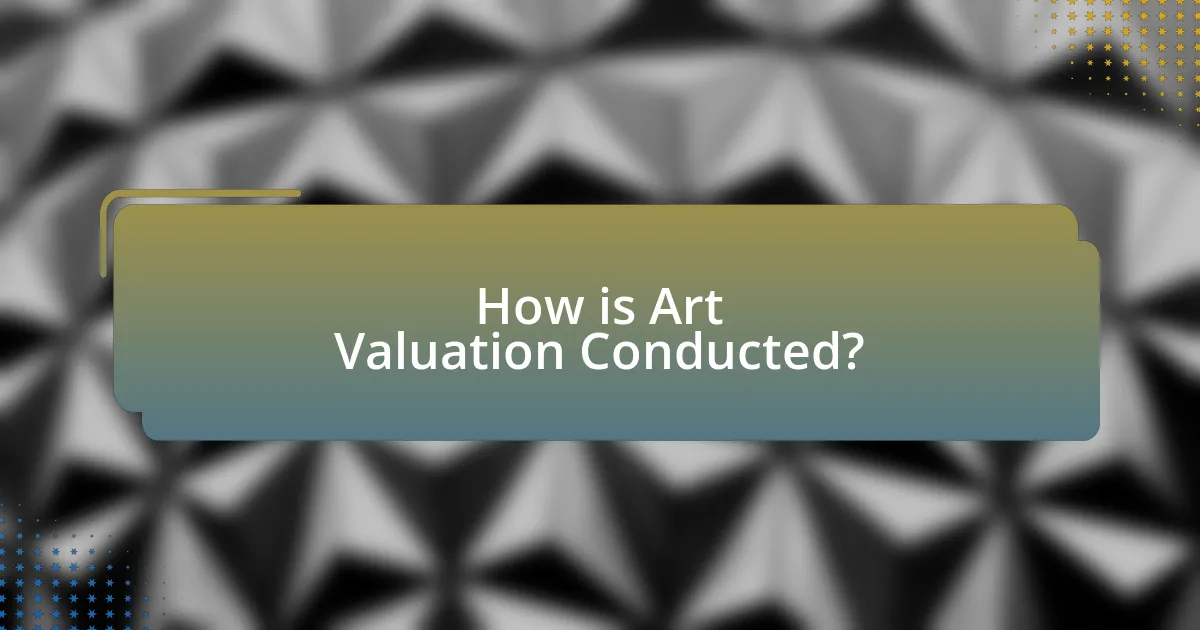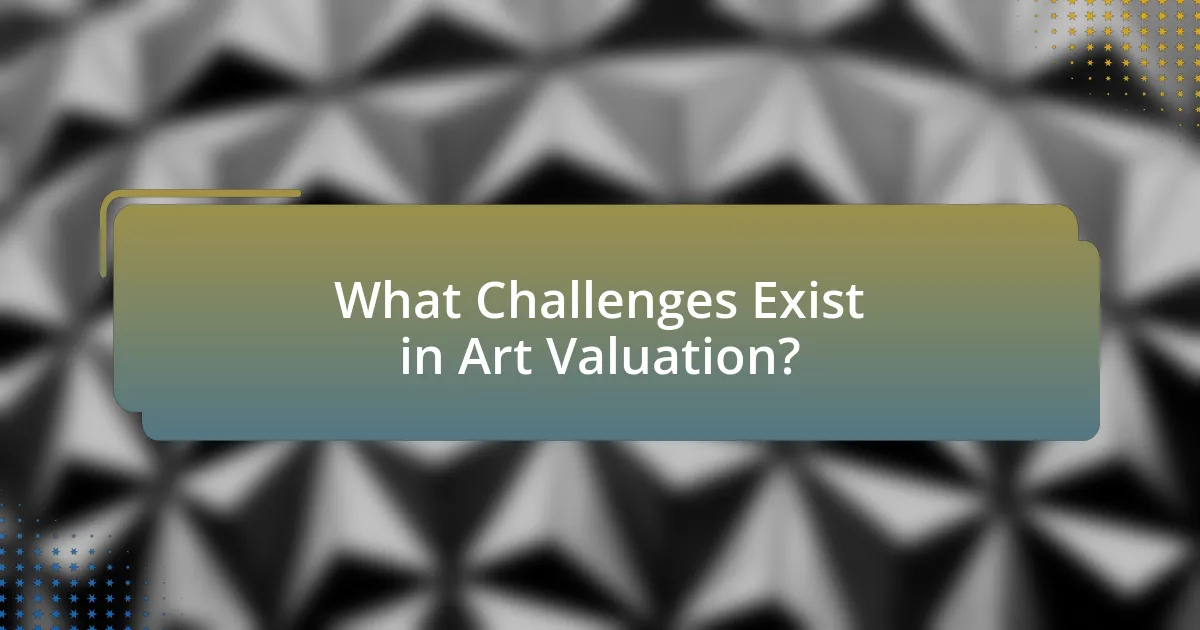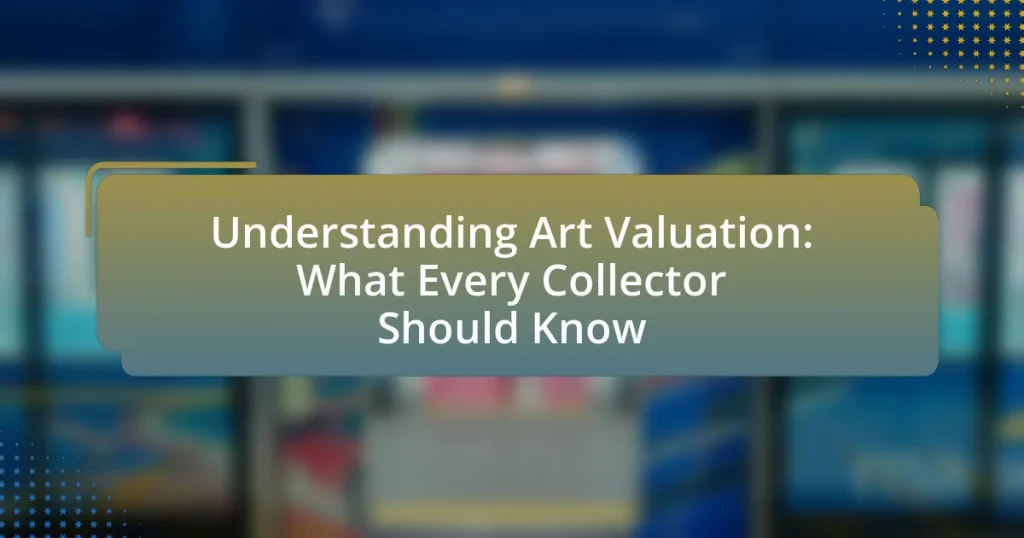Art valuation is the process of determining the monetary worth of artworks based on factors such as provenance, condition, market demand, and artist reputation. This assessment is essential for collectors, insurers, and investors, influencing decisions related to buying, selling, and insuring art. The article explores the importance of art valuation for collectors, the impact on buying and selling decisions, and its role in insurance and estate planning. It also discusses various methods of valuation, the significance of auction results, and the challenges faced in the valuation process, including misconceptions and the risks of relying on online tools. Additionally, best practices for ensuring accurate valuations and resources for ongoing education in art valuation are highlighted.

What is Art Valuation?
Art valuation is the process of determining the monetary worth of a piece of art based on various factors such as its provenance, condition, market demand, and the reputation of the artist. This assessment is crucial for collectors, insurers, and investors, as it influences buying, selling, and insuring artworks. Art valuation can be conducted by professional appraisers who utilize established methodologies and market data to provide an accurate estimate of an artwork’s value.
Why is Art Valuation Important for Collectors?
Art valuation is important for collectors because it determines the financial worth of artworks, which influences buying, selling, and insurance decisions. Accurate valuation helps collectors understand market trends, assess investment potential, and make informed purchasing choices. For instance, a 2021 report by Art Basel and UBS indicated that the global art market reached $65.1 billion, highlighting the significance of knowing an artwork’s value in a competitive market. Additionally, proper valuation is essential for insurance purposes, ensuring that artworks are adequately covered against loss or damage.
How does Art Valuation impact buying and selling decisions?
Art valuation significantly impacts buying and selling decisions by providing a quantifiable assessment of an artwork’s worth, which influences market behavior. Buyers rely on accurate valuations to determine fair prices, ensuring they do not overpay, while sellers use valuations to set competitive prices that reflect current market demand. For instance, a 2021 report by Artprice indicated that artworks with established valuations sold for 30% more on average than those without, demonstrating the financial implications of valuation in transactions. Thus, art valuation serves as a critical tool for informed decision-making in the art market.
What role does Art Valuation play in insurance and estate planning?
Art valuation is crucial in insurance and estate planning as it determines the monetary worth of artworks, ensuring adequate coverage and accurate asset distribution. Accurate art valuation helps collectors secure appropriate insurance policies that reflect the true value of their collections, protecting against potential losses from theft, damage, or market fluctuations. Additionally, in estate planning, precise valuations facilitate equitable distribution among heirs and can minimize tax liabilities, as the IRS requires fair market value assessments for estate tax purposes. Thus, art valuation serves as a foundational element in both safeguarding assets and ensuring compliance with legal and financial obligations.
What are the Different Methods of Art Valuation?
The different methods of art valuation include comparative market analysis, expert appraisal, and auction results analysis. Comparative market analysis involves evaluating similar artworks that have recently sold to determine a fair market value. Expert appraisal relies on the judgment of qualified professionals who assess the artwork’s condition, provenance, and market demand. Auction results analysis examines past auction sales to gauge the price trends and demand for specific artists or styles. Each method provides a framework for understanding the value of art based on market dynamics and expert insights.
How do appraisals differ from market comparisons?
Appraisals differ from market comparisons in that appraisals provide a formal, professional assessment of an artwork’s value based on various factors, while market comparisons analyze recent sales of similar artworks to estimate value. Appraisals are conducted by certified appraisers who consider aspects such as provenance, condition, and market trends, ensuring a comprehensive evaluation. In contrast, market comparisons rely on observable data from sales transactions, focusing primarily on price points of comparable pieces in the market. This distinction is crucial for collectors, as appraisals offer a more detailed and authoritative valuation, whereas market comparisons provide a snapshot of current market conditions.
What is the significance of auction results in Art Valuation?
Auction results are significant in art valuation as they provide concrete data on the market demand and perceived value of artworks. These results reflect the prices that buyers are willing to pay, which helps establish a benchmark for the value of similar pieces. For instance, a painting sold for $10 million at auction indicates a high demand and can influence the valuation of comparable works by the same artist or from the same period. Additionally, auction results are often used by appraisers and collectors to assess the current market trends, making them a crucial tool for informed decision-making in art investment.

How is Art Valuation Conducted?
Art valuation is conducted through a systematic process that involves assessing an artwork’s market value based on various criteria. This process typically includes examining the artist’s reputation, the artwork’s provenance, its condition, and comparable sales data from similar pieces. For instance, auction results and gallery sales provide concrete benchmarks that help establish a fair market price. Additionally, professional appraisers often utilize established methodologies, such as the sales comparison approach or the cost approach, to ensure accurate valuations. These methods are supported by industry standards set by organizations like the Appraisers Association of America, which emphasizes the importance of thorough research and documentation in the valuation process.
What Factors Influence the Value of Art?
The value of art is influenced by several key factors, including the artist’s reputation, provenance, rarity, condition, and market demand. The artist’s reputation significantly impacts value; works by renowned artists like Pablo Picasso or Vincent van Gogh command higher prices due to their established significance in art history. Provenance, or the history of ownership, adds to the value by providing authenticity and context; for example, artworks with a well-documented history can fetch higher prices. Rarity also plays a crucial role; limited editions or unique pieces are often valued more highly than mass-produced works. The condition of the artwork affects its marketability; pieces in excellent condition typically have higher values. Lastly, market demand fluctuates based on trends, economic conditions, and collector interest, which can significantly alter the perceived value of art.
How do provenance and authenticity affect valuation?
Provenance and authenticity significantly influence the valuation of art by establishing its historical significance and legitimacy. Provenance refers to the documented history of an artwork’s ownership, which can enhance its value by providing a narrative that connects it to notable collectors, exhibitions, or historical events. Authenticity, on the other hand, confirms that the artwork is genuine and created by the attributed artist, which is crucial for collectors and investors. For instance, a painting with a well-documented provenance and verified authenticity can command prices in the millions, while a similar piece lacking these attributes may be valued at a fraction of that amount. This correlation is evident in auction results, where artworks with clear provenance and authentication often achieve higher bids, reflecting their desirability and market confidence.
What impact do market trends have on Art Valuation?
Market trends significantly influence art valuation by determining the demand and pricing of artworks. When a particular style or artist gains popularity, the value of their works typically increases due to heightened interest from collectors and investors. For instance, during the contemporary art boom in the early 2000s, prices for works by artists like Damien Hirst and Jeff Koons surged, reflecting the market’s enthusiasm for contemporary pieces. Conversely, economic downturns can lead to decreased demand and lower valuations, as seen during the 2008 financial crisis when many artworks lost value due to reduced spending in the luxury market. Thus, market trends directly correlate with fluctuations in art valuation, impacting both short-term sales and long-term investment potential.
Who are the Key Players in Art Valuation?
The key players in art valuation include appraisers, auction houses, galleries, collectors, and art consultants. Appraisers provide professional assessments of an artwork’s value based on market trends, provenance, and condition. Auction houses, such as Sotheby’s and Christie’s, play a significant role by facilitating sales and establishing market prices through auctions. Galleries often influence valuation by showcasing artists and their works, while collectors contribute to the market by buying and selling art. Art consultants advise clients on acquisitions and valuations, leveraging their expertise to navigate the art market effectively.
What roles do appraisers and galleries play in the valuation process?
Appraisers and galleries play crucial roles in the art valuation process. Appraisers provide expert assessments of an artwork’s market value based on factors such as provenance, condition, and comparable sales data. They often hold certifications and adhere to professional standards, ensuring their evaluations are credible and reliable. Galleries, on the other hand, contribute to valuation by establishing market trends, showcasing artists, and facilitating sales, which helps to set price benchmarks in the art market. Their insights into current demand and collector preferences further inform the valuation process, making both appraisers and galleries integral to accurately determining an artwork’s worth.
How can collectors identify reputable valuators?
Collectors can identify reputable valuators by checking their credentials, experience, and professional affiliations. Reputable valuators typically hold certifications from recognized organizations, such as the American Society of Appraisers or the International Society of Appraisers, which ensures they adhere to industry standards. Additionally, collectors should seek valuators with extensive experience in the specific type of art or collectibles they are evaluating, as this expertise enhances accuracy. Reviews and testimonials from previous clients can also provide insight into a valuator’s reliability and professionalism.

What Challenges Exist in Art Valuation?
Art valuation faces several challenges, primarily due to subjectivity, market volatility, and lack of standardized metrics. Subjectivity arises because personal taste and emotional connections can heavily influence perceived value, making it difficult to establish a universally accepted price. Market volatility is evident in the fluctuating demand for different artists and styles, which can lead to significant price changes over short periods. Additionally, the absence of standardized metrics for assessing quality and authenticity complicates the valuation process, as collectors and appraisers may rely on differing criteria. For instance, a study by the European Fine Art Foundation reported that art prices can vary widely based on auction results, highlighting the unpredictable nature of the market.
What Common Misconceptions Do Collectors Have About Art Valuation?
Collectors often mistakenly believe that the market price of an artwork directly reflects its intrinsic value. This misconception arises because many collectors equate auction results or gallery prices with the true worth of a piece. However, art valuation is influenced by various factors, including provenance, condition, artist reputation, and market demand, which can fluctuate significantly. For instance, a painting by a well-known artist may sell for a high price at auction, but its value can be affected by its historical significance and the current art market trends. Understanding these nuances is crucial for collectors to accurately assess the value of their art investments.
How can misunderstanding valuation lead to financial loss?
Misunderstanding valuation can lead to financial loss by causing collectors to overpay for art or undervalue their own assets. When collectors misinterpret the market value of an artwork, they may purchase it at an inflated price, believing it to be a rare investment, only to find that its actual market demand is low. For instance, a study by the European Fine Art Foundation reported that 30% of art transactions involve significant discrepancies between perceived and actual value, leading to potential losses for buyers. Additionally, if collectors underestimate the value of their own pieces, they may sell them at a fraction of their worth, resulting in missed financial opportunities. Accurate valuation is crucial in the art market to avoid these pitfalls and ensure informed financial decisions.
What are the risks of relying solely on online valuation tools?
Relying solely on online valuation tools poses significant risks, including inaccuracies in valuation due to lack of context and subjective interpretation. These tools often use algorithms that may not account for unique factors such as the artwork’s provenance, condition, or market trends, leading to misleading estimates. For instance, a study by the Art Market Research Institute found that automated valuations can deviate by as much as 30% from expert appraisals, highlighting the potential for substantial financial misjudgments. Additionally, online tools may not reflect real-time market dynamics, resulting in outdated or irrelevant valuations that do not consider recent sales or shifts in collector interest.
How Can Collectors Ensure Accurate Art Valuation?
Collectors can ensure accurate art valuation by engaging professional appraisers who specialize in the specific type of art being evaluated. Professional appraisers utilize established methodologies, market analysis, and comparable sales data to determine an artwork’s value. For instance, the American Society of Appraisers provides guidelines and standards for appraisals, ensuring that collectors receive credible and reliable valuations. Additionally, collectors should stay informed about market trends and auction results, as these factors significantly influence art prices. By combining expert appraisals with ongoing market research, collectors can achieve a more accurate understanding of their art’s value.
What steps should collectors take to prepare for an appraisal?
Collectors should take several key steps to prepare for an appraisal. First, they should gather all relevant documentation, including purchase receipts, provenance records, and any previous appraisals, as these documents provide essential context and history for the appraiser. Next, collectors should clean and organize their artworks or collectibles to ensure they are presented in the best possible condition, as this can influence the appraisal outcome. Additionally, collectors should research the current market trends and comparable sales to have a better understanding of the potential value of their items. Finally, selecting a qualified appraiser with expertise in the specific type of art or collectibles is crucial, as their knowledge will significantly impact the accuracy of the appraisal. These steps collectively enhance the appraisal process and contribute to a more accurate valuation.
How often should collectors reassess the value of their art collections?
Collectors should reassess the value of their art collections at least every three to five years. This timeframe allows collectors to stay informed about market trends, changes in demand, and shifts in the art world that can affect the value of their pieces. According to a report by Artprice, the art market can fluctuate significantly, with some artists’ works appreciating or depreciating rapidly based on various factors, including exhibitions, auctions, and critical reception. Regular reassessment ensures that collectors have an accurate understanding of their collection’s worth, which is essential for insurance purposes and potential sales.
What Best Practices Should Collectors Follow for Art Valuation?
Collectors should follow several best practices for art valuation, including obtaining professional appraisals, researching market trends, and maintaining detailed documentation of their collections. Professional appraisals provide an expert assessment of an artwork’s value based on factors such as provenance, condition, and market demand. Researching market trends helps collectors understand current pricing and demand for specific artists or styles, which can fluctuate over time. Additionally, maintaining detailed documentation, including purchase receipts, exhibition history, and condition reports, supports the valuation process and can enhance the artwork’s resale potential. These practices ensure that collectors have a comprehensive understanding of their investments and can make informed decisions.
How can maintaining proper documentation enhance valuation accuracy?
Maintaining proper documentation enhances valuation accuracy by providing a clear and comprehensive record of an artwork’s provenance, condition, and market history. This detailed documentation allows appraisers to assess the artwork’s authenticity and historical significance, which are critical factors in determining its value. For instance, a study by the Art Market Research Institute found that artworks with well-documented provenance can command prices up to 30% higher than those without. Accurate records also facilitate comparisons with similar works, ensuring that valuations reflect current market trends and conditions.
What resources are available for ongoing education in Art Valuation?
Resources available for ongoing education in Art Valuation include specialized courses, workshops, and online platforms. Institutions such as Sotheby’s Institute of Art and Christie’s Education offer programs focused on art market dynamics and valuation techniques. Additionally, online platforms like Coursera and edX provide courses on art history and valuation from accredited universities. Professional organizations, such as the Appraisers Association of America, also offer webinars and certification programs that enhance knowledge in art valuation. These resources ensure that individuals stay updated on industry standards and practices.















